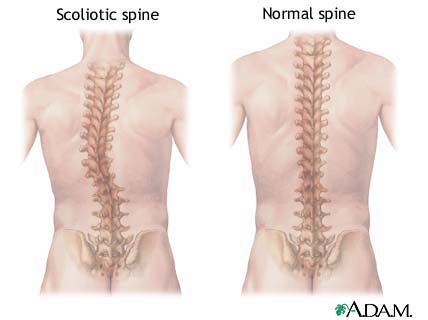Scoliosis of the spine - symptoms and treatment

What is Scoliosis
Scoliosis of the spine - An abnormal curvature that takes the spine to the side. The healthy spine does not curve to the side. Scoliosis is idiopathic—that is, doctors do not know what causes it. Treatment to straighten the spine in childhood is important because the curvature is likely to become more extreme in adulthood and can interfere with various functions, including BREATHING. Scoliosis screening among children in the public schools is common in the United States. Adult-onset scoliosis, though uncommon, may occur with OSTEOPOROSIS, RHEUMATOID ARTHRITIS, and other inflammatory conditions that affect the spine.
Symptoms of Scoliosis and Diagnostic Path
The distinguishing symptom of scoliosis is an Sshaped curvature seen in the spine from behind. Subtle symptoms of scoliosis that can help detect the condition before the curvature becomes pronounced include
- shoulders or hips that are noticeably uneven in height
- the tendency to lean to one side
- the appearance of a twisted or uneven waist
- shoulder blades that protrude prominently from the upper back
- complaints of backache or shoulder discomfort
The diagnosis of scoliosis is generally clear from physical examination, though the doctor may conduct X-RAY studies of the back to confirm it.
Scoliosis Treatment Options and Outlook
Treatment for scoliosis includes exercises to stretch and strengthen the structures of the back and often a brace that holds the spine in a more erect posture. A child may need to wear a scoliosis brace only at night or all the time, depending on the severity of the scoliosis. Severe scoliosis or scoliosis that persists despite treatment may require surgery, in which the surgeon realigns the vertebrae, sometimes bracing them with steel or titanium rods to maintain them in proper position. Most scoliosis, when detected early, responds very well to treatment and is gone by the time the child reaches late ADOLESCENCE.
Scoliosis - Risk Factors and Preventive Measures
Because doctors do not know what causes most scoliosis, there are no known risk factors or preventive measures. Scoliosis often accompanies other conditions such as CEREBRAL PALSY, MUSCULAR DYSTROPHY, and SPINA BIFIDA. Health experts urge women of childbearing age to take folic acid supplements, which can prevent many NEURAL TUBE DEFECTS such as spina bifida. It also tends to run in families, leading doctors to suspect there are hereditary factors at play.
See also KYPHOSIS; LORDOSIS; SURGERY BENEFIT AND RISK ASSESSMENT.
Open discussion on the topic Scoliosis of the spine - symptoms and treatment
Similar interests
- Nuovi Casino
- Casinos Not On Gamstop
- UK Casinos Not On Gamstop
- Casinos Not On Gamstop
- UK Casinos Not On Gamstop
- Casino Non Aams Italia
- Slot Sites Not On Gamstop
- Meilleur Casino En Ligne
- Non Gamstop Casino Sites UK
- Meilleur Casino En Ligne
- Casino En Ligne France
- Best Non Gamstop Casinos
- Casinos Not On Gamstop
- UK Casino Not On Gamstop
- Casinos Not Signed Up To Gamstop
- Best Slot Sites UK
- Non Gamstop Casino Sites UK
- Online Casinos Nederland
- Online Casinos Nederland
- Casinos Not On Gamstop
- Best New Uk Casinos Not On Gamstop
- Casino Non Aams
- Non Gamstop Casinos UK
- Migliori Siti Casino Non Aams